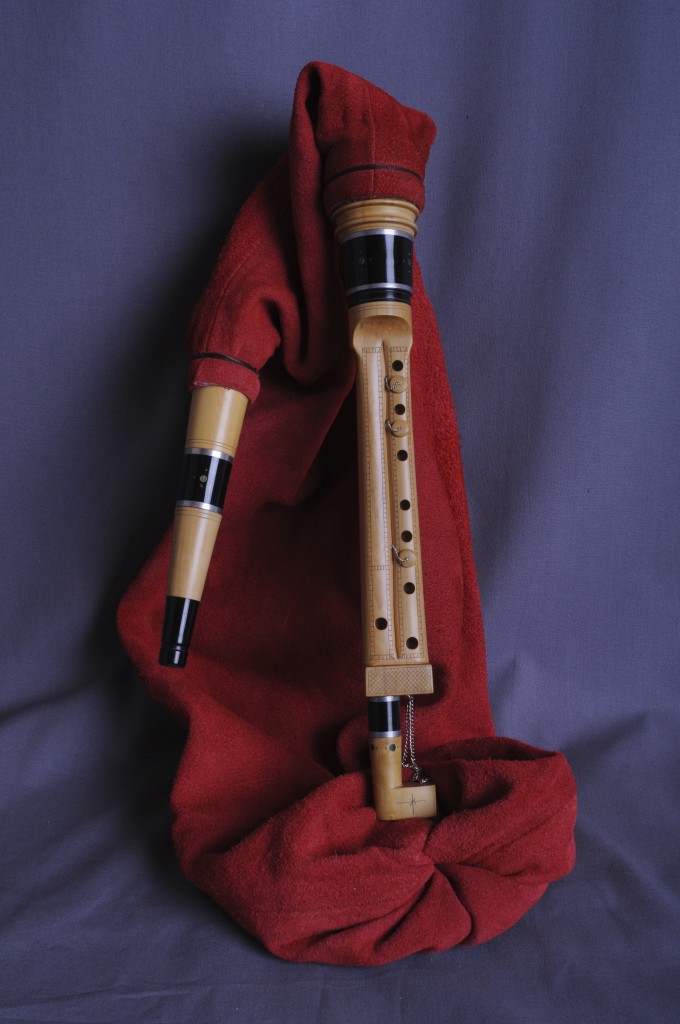Everything began for me in 1976. I was twenty when I discovered the treasury of wind instruments of Occitany*…
My first contact was with the “Limousine chabrette” when I encountered Eric Montbel at the Occitan Conservatory at Toulouse. At this period Eric played on ancient instruments that he himself had discovered thanks to the work of “collectage” accomplished in the Limousin. The only solution that occurred to me was to reconstruct my own instrument based on that of an ancient chabrette and so, after several months, I made my first.
Of course it wasn’t perfect but the work was begun and was never to let me go. Today I specialize in making Occitan bagpipes, essentially the Boha, the Boudègue, the Samponha and the Limousin chabrette. Many articles have already been written describing the Chabrette and the Boha, hence I will concentrate on presenting for you the Bohassa, the Boudègue and the Samponha.
* Occitany is globally all the south of France, from Bordeaux to Nice, including the Limoges region.
The greatest part of my activity concerns the Boha and the innovations that I brought to it.

Originally the Boha was a small instrument with very high pitched sonority. The instrument possessed only five holes on the front face of the chanter and at present my instruments are proposed with six holes as standard, with the possibility to play in minor modes, thanks to little corks that can be moved from one hole to another. The system of reeds that I use for my “Bohas and Bohassas” are made from Plexiglas for the reed body and carbon fibre for the reed itself.
What I innovated was to extend the range of the Boha into the lower registers. I called these new instruments “Bohassas”.

Bohassas are played essentially in D and C and have a warm deep sound contrasting to the standard Boha. The possibility to mix treble Bohas with Bohassas makes me think of the mixture one finds in central France between the 16 and 20 inch Musettes. Of course the sound is dissimilar due to the reeds that are single in the case of the Bohassa. The Bohassa is an invention, but already many musicians who play medieval music have adopted it, considering it as being a period bagpipe and not a modern creation. Nonetheless the reed in carbon fibre is very modern and in no way resembles cane reeds which are typical of ancient Bohas.
One would hope that the sound of Bohassas makes one think of the Middle-Ages and the sonorities that must have reigned in the halls of medieval castles.
At present, my Bohassas are played by numerous musicians playing early music but equally by those playing traditional.
In 2002 I continued the evolution of the standard Bohassa by making it polyphonic.
I gave it the name “Polyphonic Bohassa”.

The idea was very simple: separate the melody in two parts. The standard Bohassa possesses two bores and in the case of the polyphonic Bohassa there are three: Four holes in the middle chanter (occupied by the right hand) and five on the left chanter (for the left hand). The right channel is still a semi-melodic drone as on the standard Bohas.
No other bagpipe resembles the Polyphonic Bohassa in its organology thanks to the two melodic chanters and its semi-melodic drone, with its specific little wooden piece called “Brunider” in Gascon. Only those bagpipes from central Europe, like the Duda, present this peculiarity.
Lately, my invention was taken over by other luthiers, without my consent. This is regrettable but proves at least that the idea was good enough to be copied.
